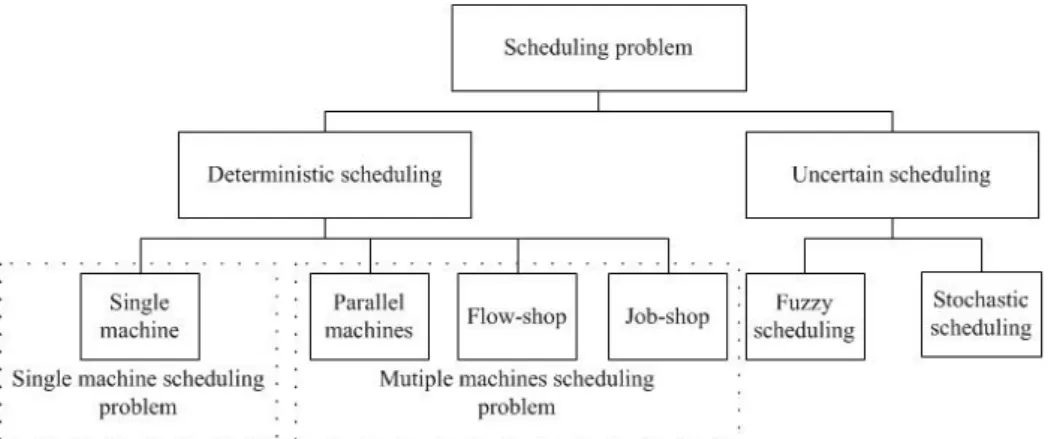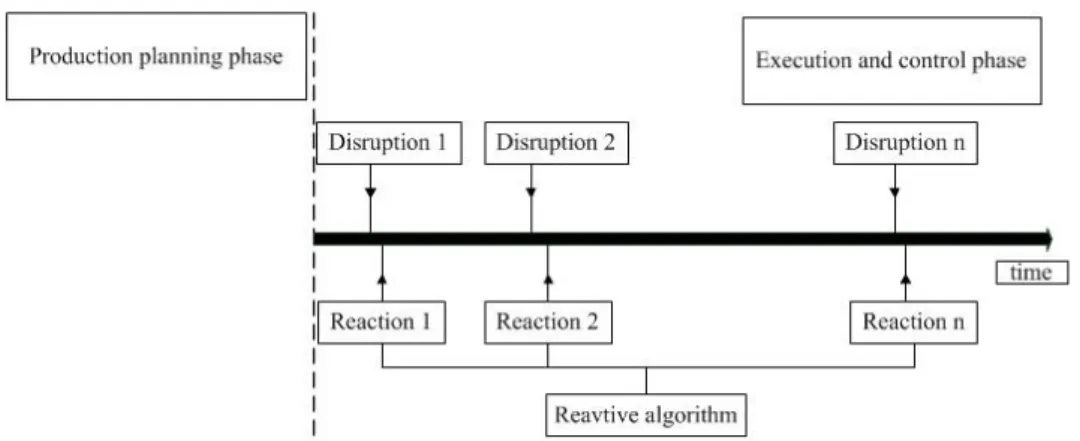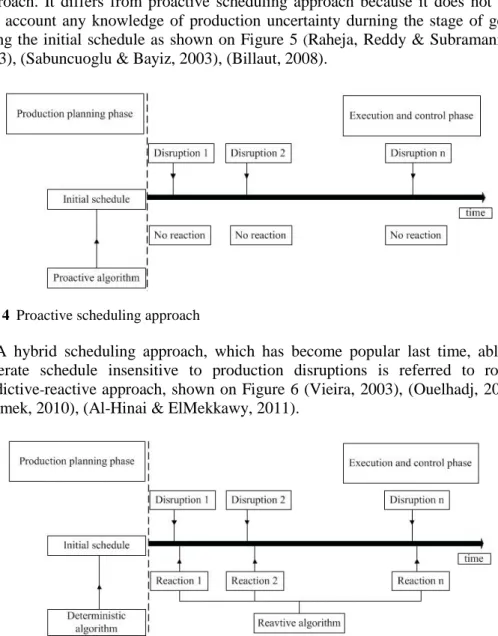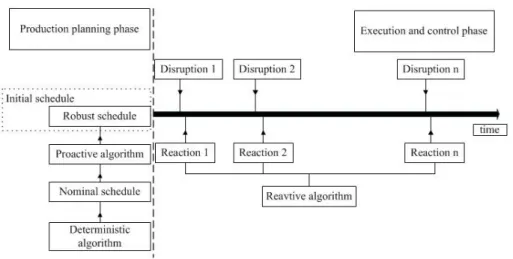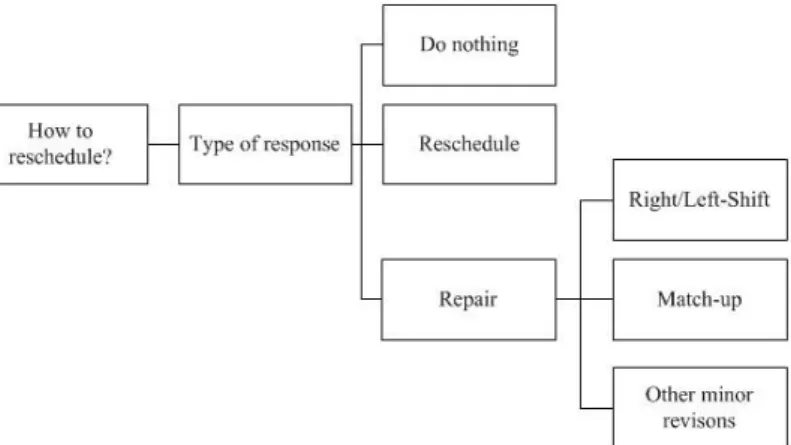THE CLASSIFICATION OF SCHEDULING PROBLEMS
UNDER PRODUCTION UNCERTAINTY
Paweł Wojakowski* and Dorota Warżołek**
* Cracow University of Technology, Institute of Production Engineering and Automation, al. Jana Pawla II 37, 31-864 Cracow, Poland,
Email: pwojakowski@pk.edu.pl
** Cracow University of Technology, Institute of Production Engineering and Automation, al. Jana Pawla II 37, 31-864 Cracow, Poland,
Email: dorotawarzolek@gmail.com
Abstract One of the most important issue regarding scheduling problem is production uncertainty. From the standpoint of real-world scheduling problem, it is necessary to find solution of building the schedule which can be insensitive to production disruptions such as machine breakdowns, incorrectly estimated time interval of machines maintenance, absence of workers, unavailability of materials or tooling, production defects, variable processing times, etc. This research study is conducted to answer the question: how the researchers cope with the problem of production uncertainty taking into account the scheduling problem? Our investigation focuses on approaches developed for scheduling with production uncertainty consideration. Among these approaches the most popular ones are: reactive scheduling, proactive scheduling, predictive scheduling and robust predictive-reactive approaches. A brief explanation of individual approaches are presented. Further, models of uncertainty used in scheduling approaches are highlighted.
Paper type: Research Paper Published online: 09 July 2014 Vol. 4, No. 3, pp. 245-255 ISSN 2083-4942 (Print) ISSN 2083-4950 (Online)
© 2014 Poznan University of Technology. All rights reserved.
1. INTRODUCTION
Regarding scheduling problems a very important issue is the ability to dis-tinguish the term uncertainty from the term of imprecision both associated with the concept of risk.
The uncertainty of the event is the lack of knowledge (or incomplete knowledge) whether a particular event will occur in the future or not, while the term imprecision means no precise knowledge (accurate information) relating to exactly when the event will occur in the future, which involves, in turn, the risk of an event (Bidot, 2005).
Depending on the degree of knowledge of the uncertainty sources, three types of uncertainty are distinguished in the literature as follows (Murakami & Morita, 2009):
1. Complete unknown. This type of uncertainty refers to a entirely unforeseen event, such as a disaster, and which is characterized by the absence of any prior information about it,
2. Suspicion about the future. This supposes a specific event in the future based on intuition and experience of an expert in scheduling process,
3. Known uncertainty. There are some available information about the unplanned events which have already happened while the scheduling process was being conducted in the past.
Various approaches to model of known uncertainty in the scheduling problem have been developed, which include (Herroelen & Leus, 2005,Klimek, 2010): 1. Probabilistic modeling, which is associated with stochastic scheduling, 2. Fuzzy modeling based on fuzzy logic, related to fuzzy scheduling.
The production uncertainty which occurs in manufacturing systems can be defined as a set of categorized production disruptions. The knowledge about diffe-rent kinds of these disruptions is used during the scheduling process. The basic categories of production disruptions contain events such as machines breakdowns, incorrectly estimated time interval of machines maintenance, absence of workers, unavailability of materials or tooling, production defects, variable processing times. This definition of production uncertainty constitutes a foundation of our research investigation. We are trying to find the answer on the question: how the researchers cope with the problem of production uncertainty taking into account the scheduling problem? Therefore, a brief review of approaches of scheduling under uncertainty are presented in this paper. The fundamental part of this part is devoted to classification of scheduling problems under production uncertainty.
2. CLASSIFICATION OF SCHEDULING PROBLEMS UNDER
UNCERTAINTY
In the state-of-the-art literature many approaches can be found to classify the scheduling problem under production uncertainty (Li & Ierapetritou, 2008, Rasconi, Cesta & Policella, 2010, Lin, Gen, Liang & Ohno, 2012, Sotskov, Lai & Werner, 2013). However, currently one of the most popular classification in this problem is carried out by Nagar, Haddock & Heragu, 1995. It confirms the survey conducted by Lei, 2009 with regard to the multi-obcjective optimization of scheduling problem.
Based on the classification made by Nagar, Haddock & Heragu, 1995, sche-duling problems are considered due to the following criteria: the nature of problem, the number of machines involved, the method of solving problem and performance measures of schedule.
Given the nature of the problem, scheduling process is divided into two classes of problems such as deterministic scheduling and uncertain scheduling (Fig. 1).
Fig. 1 The classification of scheduling problems according to Nagar, Haddock & Heragu, 1995
Another frequent cited classification of scheduling problem with production uncertainty is prepared by Vieira, Herrmann & Lin, 2003. In this classification shown in Figure 2, scheduling problem is considered on the basis of the following criteria: scheduling enviroment and the nature of problem. Here, two classes of problems can be distinguished:
1. Static scheduling enviroment also known as static scheduling. It characterizes constant, unchanged production schedule during the execution phase as well as finite number of jobs known at the time when the schedule is built. Further classification of static scheduling is conducted as follows:
• Deterministic scheduling, which occurs when all the parameters of the ma-nufacturing system and operations performed inside the system are fixed and known. Production disruptions do not happen.
• Stochastic scheduling, which occurs when selected part of data about the manufacturing system and operations performed are uncertain.
2. Dynamic scheduling enviroment also called dynamic scheduling. This type of scheduling characterizes non-fixed, variable durning production schedule in the execution phase. Infinite number of jobs arriving at different time periods are scheduled while previously scheduled jobs have been already executed. Dynamic scheduling environment is further divided into two groups of prob-lems, depending on whether arrival times of jobs are charged with uncertainty or not, which are:
• Dynamic scheduling with known arrival time of jobs in advance. Jobs arrive to the manufacturing system at a specified time and in the same order. This problem is also called cyclic scheduling problem.
• Dynamic scheduling with uncertainty, in which arrival time of jobs is unknown.
Vieira, Herrmann & Lin, 2003 also take into account the nature of the problem (the nature of the scheduling environment), but they distinguish slightly different classification in this context, namely:
1. Deterministic scheduling,
2. Non-deterministic scheduling that can concern both static (stochastic scheduling) as well as dynamic scheduling environment due to uncertainty and/or variability that can occured in it.
Fig. 2 The classification of scheduling problems by Vieira, Herrmann & Lin, 2003
It is worth noticing that all above discussed classifications can be used to describe both deterministic and non-deterministic production scheduling problems. In the next subsections we investigate the approaches that are developed to cope with classified scheduling problems under production uncertainty.
2.1. Approaches for scheduling under production uncertainty
In general, there are two types of approaches used in scheduling process under production uncertainty, namely, proactive and reactive scheduling approaches (Gören & Sabuncuoglu, 2008, Sabuncuoglu & Gören, 2009, Ghezail, Pierreval & Hajri-Gabouj, 2010). The appropriate selection of the scheduling approach depends on the scheduling environment and some assumptions that are taken into account when analyzing manufacturing system.
The characteristic feature of reactive scheduling approach under production uncertainty is that it refers only to the dynamic scheduling, that is to environment with dynamic nature of problems (Aytug, Lawley, McKay, Mohan & Uzsoy, 2005, Billaut, Maukrim & Sanlaville, 2008, Murakami, 2009, Ouelhadj & Pertovic, 2009). In the literature, reactive scheduling is also defined as dynamic scheduling because schedule is built or rebuilt every time a new job arrives to the manu-facturing system (Ouelhadj, 2009), (Klimek, 2010).
In the reactive scheduling approach knowledge of possible production disruptions is not taken into account when assigning operations to specific resources. It means that the first reaction happens after disruption has appeared. However, decisions made to rebuilt the schedule in reactive scheduling approach have usually locally nature because, only a part of the schedule is taken into account when they are made asign Figure 3 (Aytug, 2005), (Murakami, 2009), (Ouelhadj, 2009).
Fig. 3 Reactive scheduling approach
Proactive scheduling approach differs substantially from reactive scheduling approach. The difference is noticeable as depicted on Figure 4. The characteristic features of proactive scheduling approach are:
1. The moment when proactive schedule is generated. Proactive schedule is also called robust schedule.
2. Knowledge about production disruptions which are sources of production uncertainty during a generation process of a proactive schedule.
The main objective of proactive scheduling approach is to create a robust schedule that will minimize the impact of production disruptions on jobs execution into the manufacturing system. In other words, the aim is to generate a schedule that will absorb production disruptions occured durning the execution phase (Herroelen, 2005), (Billaut, 2008), (Sabuncuoglu, 2009).
In the literature the term of predictive scheduling approach can be also met (Petrovic & Duenas, 2006). This approach derives from reactive scheduling approach. It differs from proactive scheduling approach because it does not take into account any knowledge of production uncertainty durning the stage of gene-rating the initial schedule as shown on Figure 5 (Raheja, Reddy & Subramaniam, 2003), (Sabuncuoglu & Bayiz, 2003), (Billaut, 2008).
Fig. 4 Proactive scheduling approach
A hybrid scheduling approach, which has become popular last time, able to generate schedule insensitive to production disruptions is referred to robust predictive-reactive approach, shown on Figure 6 (Vieira, 2003), (Ouelhadj, 2009), (Klimek, 2010), (Al-Hinai & ElMekkawy, 2011).
This approach combines the three aforementioned approaches. The robust predictive-reactive scheduling approach is divided into the following phases of scheduling process:
1. Predictive scheduling phase related to the production planning phase. In this phase two schedules are created as follows:
• nominal and deterministic schedule taking into account only performance measures of manufacturing system,
• proactive (robust) schedule as a modified nominal schedule, which also includes the production uncertainty so as to minimize the effects of the impact of production disruptions on performance criteria of the manufa-cturing system.
2. Reactive scheduling phase related to the production execution phase. In this phase unexpected production disruptions are handled based on reactive schedu-ling approach.
Additionally, in the second phase of robust predictive-reactive scheduling approach the following two questions: "when to respose?" and "how to react?" are fundamental in order to react on production disruptions.
Fig. 6 Robust predictive-reactive scheduling approach
The first question relates to the determination of the moment in time that the decision about making changes in schedule in response to emerged disruption should be undertaken. Researchers has proposed several alternative approaches to sol-ving this problem, namely, continuous rescheduling (Yin, Li, Chen & Wang, 2011), periodic rescheduling (Olteanu, Pop, Dobre & Cristea, 2012), eventdriven rescheduling (Palombarini & Martínez, 2012), hybrid rescheduling (Zhao C & Tang, 2010).
The second question refers to different types of responses to production disruptions based on possibilities of making necessary changes in schedule. All
possible types of responses to production disruptions are divided into the following three groups: do nothing, reschedule and repair (Fig. 7) (Raheja, 2003), ( Subrama-niam & Raheja, 2003), (Lin, Janak & Floudas, 2004).
Fig. 7 The types of responses to production disruptions
2.2. Models of production uncertainty used in scheduling approaches
All aforementioned approaches of scheduling under production uncertainty, exploit models of uncertainty associated with production disruptions. Generally, these models can be divided into two groups:1. scenario-based models also called scenario planning models, 2. probabilistic models.
In fact, both groups of models are considered as mutually substituted, in the sense that a probabilistic model can be considered as a scenario-based model with a continuous set of infinite scenarios. On the other hand, the probability of every scenario in a scenario-based model is expressed by means of the probability density functions, which are used in a probabilistic approach. Hence, measures which are used to assess the ability of the initial schedule to absorb production disturbances are the same in both of these models. In the literature, these measures are divided into two groups, i.e. robustness measures and stability measures (Sabuncuoglu, 2009).
For a finite and known in advance number of scenarios calculation of the above-mentioned measures is very easy. In practice, however, for any scheduling prob-lem, the number of possible scenarios to be considered can be infinitely large. In such cases, an effective way to assess the degree of the schedule robustness turns out to be an approach based on surrogate measures. The surrogate measures that allow to estimate the schedule robustness in approximate way should be used in all cases in which the number of scenarios is infinitely large, with two following
exceptions, i.e. only the worst or the best scenario when the calculation of schedule robustness is taken into account (Gören, 2002), (Gören, 2008), (Xiong, Li-Ning & Ying-wu, 2013).
3. CONCLUSION
Scheduling approaches under production uncertainty are highlighted in this chapter to find the answer on the question: how the researchers cope with the problem of production uncertainty taking into account the scheduling problem? Our investigation research shows, that over last dacade four approaches, namely, reactive scheduling, proactive scheduling, predictive-reactive scheduling and robust predictive-reactive scheduling approach are developed and fundamentally exploited in scheduling problem regarding production uncertainty. Moreover, it can be noticed that research attention on the problem of scheduling with production uncertainty has still growing becouse of the proximity to real-world problems occuring in manufacturing systems.
Among reviewed in this chapter approaches robust predictive-reactive schedu-ling approach seems to be the most intensively developed one.
On the other hand, researchers’ efforts are concentrated on elaborating more and more new robustness and stability measures of production schedules that will protect the baseline schedule against future disruptions with more accurate way.
REFERENCES
Al-Hinai N. & ElMekkawy T.Y., (2011), "Robust and stable flexible job shop scheduling with random machine breakdowns using a hybrid genetic algorithm", International Journal of Production Economics, Vol.132, No.2, pp. 279-291.
Aytug H., Lawley M.A., McKay K., Mohan S. & Uzsoy R., (2005), "Executing production schedules in the face of uncertainties: A review and some future directions", European Journal and Operational Research, Vol.161, No.1, pp. 86-110.
Bidot J., (2005), "A general framework integrating techniques for scheduling under uncertainty", PhD dissertation, Institut National Polytechnique de Toulouse, France. Billaut J.C., Maukrim A. & Sanlaville E., (2008), "Introduction to flexibility and robustness
in scheduling", J.C. Billaut, A. Maukrim, E. Sanlaville (Ed.), Flexibility and robustness in scheduling, ISTE Ltd, London, pp. 15-31.
Ghezail F. Pierreval H. & Hajri-Gabouj S., (2010) "Analysis of robustness in proactive scheduling: A graphical approach", Computers & Industrial Engineering, Vol.58, No.2, pp. 193-195.
Gören S., (2002), "Robustness and stability measures for scheduling policies in a single machine enviroment", MSc dissertation, Bilkent University, Ankara.
Gören S. & Sabuncuoglu I., (2008) "Robustness and stability measures for scheduling: single-machine enviroment", IIE Transactions, 193–198, Vol.40, No.1, pp. 66-83.
Herroelen W. & Leus R., (2005), “Project scheduling under uncertainty: Survey and research potentials”, European Journal and Operational Research, Vol.165, No.2, pp. 289-306.
Klimek M., (2010), "Predictive-reactive scheduling with resource constraints", PhD dissertation, AGH University of Technology, Kraków.
Lei D., (2009) "Mutiple-objective production scheduling: a survey", International Journal of Advanced Manufacturing Technology, Vol.43, No.9-10, pp. 926-938.
Leon D.J., (1994), "Robustness measures and robust scheduling for jon shops", IIE Transactions, Vol.26, No.5, pp. 32-43.
Li Z., Ierapetritou M., (2008), "Process scheduling under uncertainty: Review and challenges", Computers & Chemical Engineering, Vol.32, No.4–5, pp.715–727. Lin L., Gen M., Liang Y., Ohno K., (2012), "A hybrid EA for reactive flexible job-shop
scheduling", Procedia Computer Science, Vol.12, pp.110-115.
Lin X., Janak S.L. & Floudas C.A., (2004), "A new robust optimization approach for scheduling under uncertainty:: I. Bounded uncertainty", Computers & Chemical Engineering, Vol.28, No.6–7, pp.1069–1085.
Murakami K.. & Morita H., (2009), "A method for generating robust schedule uncertainty in processing time", Biomedical Soft Computing and Human Sciences, Vol.15, No.1, pp. 47-52.
Nagar A., Haddock J. & Heragu S., (1995), "Mutiple and bicriteria scheduling: a literature survey processing time", European Journal and Operational Research, Vol.81, No.1, pp. 88-104.
Olteanu A., Pop F., Dobre C. & Cristea V., (2012), "A dynamic rescheduling algorithm for resource management in large scale dependable distributed systems", Computers & Mathematics with Applications, Vol.63, No.9, pp.1409–1423.
Ouelhadj D. & Pertovic S., (2009), "A surey of dynamic in manufacturing systems", Journal of Scheduling, Vol.12, No.4, pp. 417-431.
Palombarini J. & Martínez E., (2012), "SmartGantt – An intelligent system for real time rescheduling based on relational reinforcement learning", Expert Systems with Applications, Vol.39, No.11, pp.10251–10268.
Petrovic D. & Duenas A., (2006), "A fuzzy logic based production scheduling/rescheduling in the presence of uncertain disruptions", Fuzzy Sets and Systems, Vol.157, No.16, pp. 2273–2285.
Raheja A.S., Reddy K.R.B., Subramaniam V., (2003), "A generic mechanism for repairing job shop schedules", available at: http://dspace.mit.edu/bitstream/handle/1721.1/3744/-IMST010_Reddy.pdf?sequence=2 (accessed 12 July 2013).
Rasconi R., Cesta A. & Policella N., (2010), "Validating scheduling approaches against executional uncertainty", Journal of Intelligent Manufacturing, Vol.21, pp.49-64. Sabuncuoglu I. & Bayiz M., (2003), "Analysis of reactive scheduling problems in a job shop
environment", European Journal of Operational Research, Vol.126, No.3 pp. 567-586. Sabuncuoglu I. & Gören S., (2009), "Hedging production schedules against uncertainty
in manufacturing enviroment with a review of robustness and stability research", International Journal of Computer Integrated Manufacturing, Vol.22, No.6 pp. 138-157. Sotskov Y.N. & Lai T.C., Werner F., (2013), "Measures of problem uncertainty for
Subramaniam V., Raheja A.S., (2003), "mAOR: A heuristic-based reactive repair mechanism for job-shop schedules", International Journal of Advanced Manu-facturing Technology, Vol.22, pp.669-680.
Vieira G.E., Herrmann J.W. & Lin A.E., (2003), "Rescheduling manufacturing systems: a framework of strategies, policies, and method", Journal of Scheduling, Vol.6, No.1, pp. 39-62.
Xiong J., Li-Ning X. & Ying-wu Cz., (2013), "Robust scheduling for multi-objecitve flexible job-shop problems with random machine breakdowns", International Journal of Production Economics, Vol.141, No.1, pp.112–126.
Yin J., Li T., Chen B. & Wang B., (2011), "Dynamic rescheduling expert system for hybrid flow shop with random disturbance", Procedia Engineering, Vol.15, pp. 3921–3925. Zhao C. & Tang H., (2010), "Rescheduling problems with deteriorating jobs under
disruptions", Applied Mathematical Modelling, Vol. 34, No.1, pp. 238–243.
BIOGRAPHICAL NOTES
Paweł Wojakowski is an Assistant Professor at Cracow Univeristy of Technology.
He teaches subjects involved organization and production management such as “Design of Manufacturing Systems”, “Reorganization – Lean Manufacturing”, “Production Management” as well as focused on computer aided based like “Enterprise Resource Planning”, “Informatics in Management Practice”. His re-search interests are cell formation problem, facility layout planning, design of lean production systems, and scheduling and inventory control problems. He is a mem-ber of The Polish Association for Production Management. His work is directly affected real-world problems, he has worked for commercial corporations such as GK Kęty, TQMsoft since 2009.
Dorota Warżołek is currently a Doctoral Student at Institute of Production
Engineering and Automation at Cracow University of Technology. Her research interests include production scheduling and process optimization, machining and assembly process design, programming of CNC machine tools, methods of working time measuring and standardization of work time.
256 P. Wojakowski and D. Warżołek
